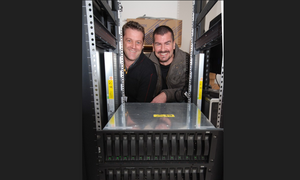Night voyage to Barcelona
Every night around 11 p.m. hard disks start clicking and whirring in a secure room on the first floor of JWS2. Bit by bit, all the data that has been produced and locally saved by ITER over the past 15 hours embarks on a long night voyage through cyberspace. By early morning all emails, spreadsheets, heavy files from the Design Office and other "strategic data" will have reached their destination. Another rack of hard disks, in another safe room some 550 kilometres further south in Barcelona, at the "Fusion for Energy" Office.
Remote backup, which is operational since the end of December 2008, has been set up by the "Osiatis team"—some ten people within the IT division who are in charge of systems administration and user support.
Remote backup is to ITER what a USB key or a portable disk is to every one of us: a way to make sure that there is always a backup, whatever happens to the original data.
A remote backup though is not just an oversized storage device. It comes with an array of redundant safeguards and controls, both logical and physical, which guarantee that—should a major problem arise here—ITER could be "restarted" from Barcelona and no data would be lost.
With data travelling 60 to 70 times faster than through a standard DSL connection, the whole saving process is usually completed within two to six hours, depending on the amount of data produced over the day.
"Based on experience and projections, we have set up a total storage capacity of 30 terabytes (30,000 gigabytes), with the option to add more disks as ITER grows," says Cedric Chaumette, the Osiatis team leader in charge of the operation.



